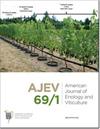Climate Change Impacts on Vineyards in Warm and Dry Areas: Challenges and Opportunities
IF 1.8
3区 农林科学
Q3 BIOTECHNOLOGY & APPLIED MICROBIOLOGY
引用次数: 0
Abstract
Background and goals
Climate change is challenging grape production everywhere, but especially in regions with warm and dry climates. Rising temperatures are increasing the plant water demand while decreasing the irrigation water supply. This overview explores how temperature and water availability impact grapevines to inform practices in warm-climate viticulture.Methods and key findings
Integrating an historical perspective with recent physiological and phenological research shows that Vitis vinifera is a rather heat- and drought-tolerant species whose cultivars differ in their adaptability to diverse climates. Water-stressed grapevines reduce canopy gas exchange and growth, leading to more sun-exposed, and hence warmer, clusters with smaller berries, which alters grape composition. Both excessive heat and drought stress limit crop yield, and drought stress may threaten plant survival. Rising temperatures accelerate vine growth and development, and may advance or delay fruit ripening, but temperature responses and thresholds remain to be quantified. Exploiting the existing genetic diversity and using mechanization to manipulate crop yields may be effective strategies to counter the trend to earlier harvests and higher wine alcohol contents and to improve vineyard water-use efficiency.Conclusions and significance
Though climate change poses challenges to the global grape and wine industries, the work reviewed here shows that grapevines are resilient and vary in their adaptability. This article encourages further research into utilizing the inherent genetic diversity of grapevines to choose or develop adapted cultivars and other mitigation strategies related to vineyard management.气候变化对温暖干燥地区葡萄园的影响:挑战与机遇
背景与目标气候变化给葡萄生产带来了挑战,尤其是在气候温暖干燥的地区。气温上升增加了植物需水量,同时减少了灌溉用水。这篇综述探讨了温度和水分供应如何影响葡萄树,为温暖气候下的葡萄栽培实践提供信息。短句来源从历史的角度结合近年来的生理物候研究表明,葡萄是一种耐热、耐旱的植物,其品种对不同气候的适应能力存在差异。缺水的葡萄藤减少了树冠的气体交换和生长,导致更多的阳光照射,因此更温暖,果实更小,这改变了葡萄的成分。高温和干旱胁迫都限制了作物产量,干旱胁迫可能威胁植物的生存。气温上升加速了葡萄的生长和发育,并可能提前或延迟果实的成熟,但温度反应和阈值仍有待量化。利用现有的遗传多样性和利用机械化来控制作物产量可能是对抗提前收获和葡萄酒酒精含量高的趋势和提高葡萄园用水效率的有效策略。尽管气候变化给全球葡萄和葡萄酒行业带来了挑战,但本文综述的工作表明,葡萄具有弹性,其适应性各不相同。本文鼓励进一步研究利用葡萄固有的遗传多样性来选择或开发适应性品种以及与葡萄园管理相关的其他缓解策略。
本文章由计算机程序翻译,如有差异,请以英文原文为准。
求助全文
约1分钟内获得全文
求助全文
来源期刊

American Journal of Enology and Viticulture
农林科学-生物工程与应用微生物
CiteScore
3.80
自引率
10.50%
发文量
27
审稿时长
12-24 weeks
期刊介绍:
The American Journal of Enology and Viticulture (AJEV), published quarterly, is an official journal of the American Society for Enology and Viticulture (ASEV) and is the premier journal in the English language dedicated to scientific research on winemaking and grapegrowing. AJEV publishes full-length research papers, literature reviews, research notes, and technical briefs on various aspects of enology and viticulture, including wine chemistry, sensory science, process engineering, wine quality assessments, microbiology, methods development, plant pathogenesis, diseases and pests of grape, rootstock and clonal evaluation, effect of field practices, and grape genetics and breeding. All papers are peer reviewed, and authorship of papers is not limited to members of ASEV. The science editor, along with the viticulture, enology, and associate editors, are drawn from academic and research institutions worldwide and guide the content of the Journal.
 求助内容:
求助内容: 应助结果提醒方式:
应助结果提醒方式:


